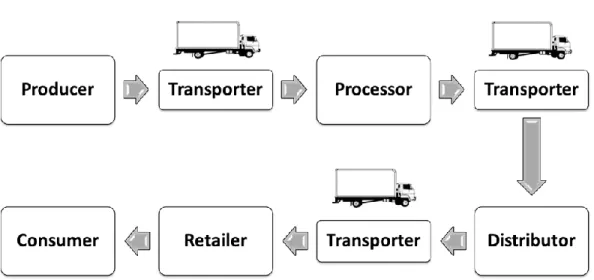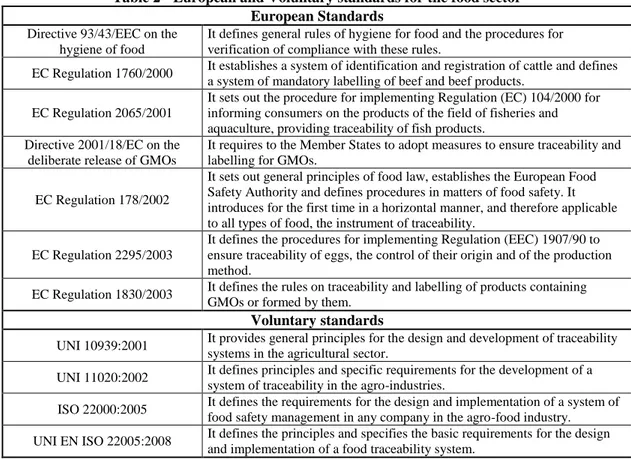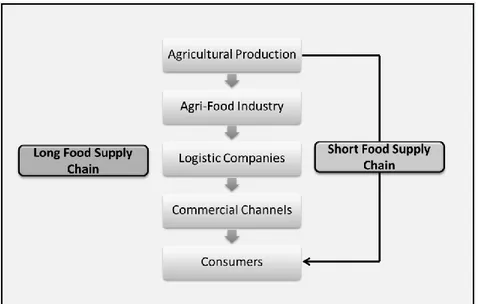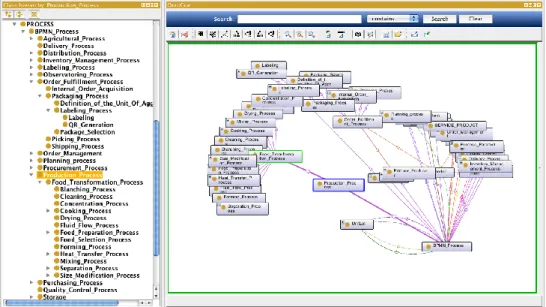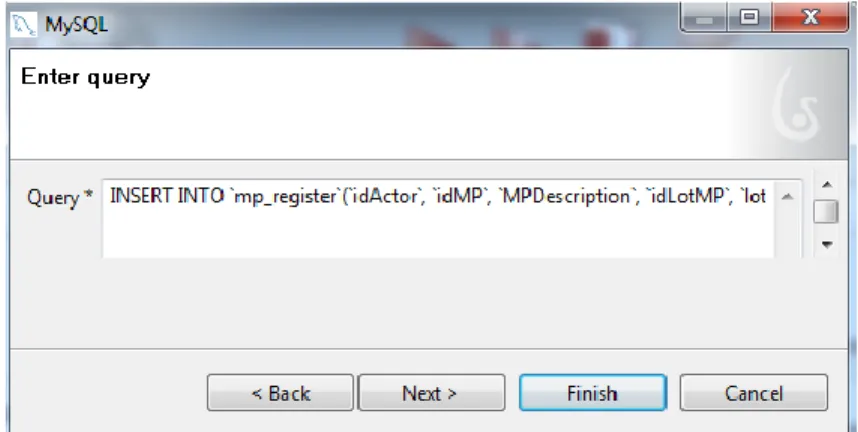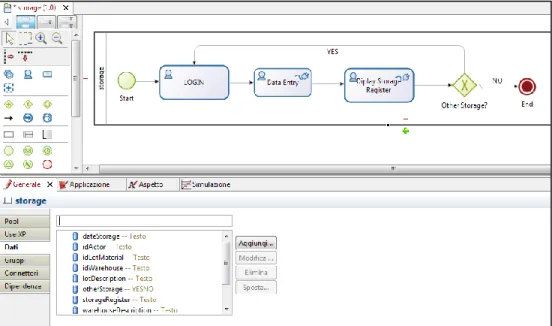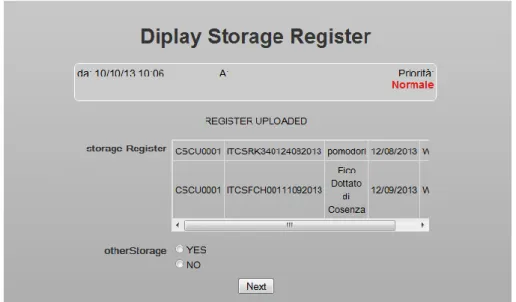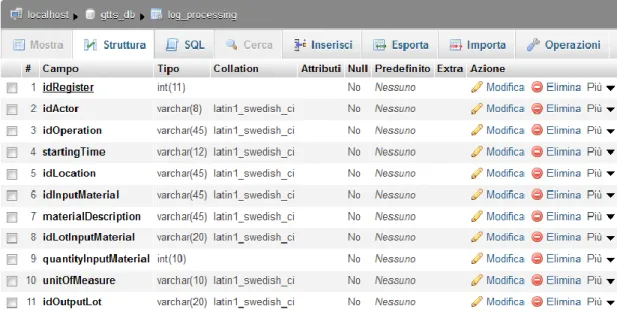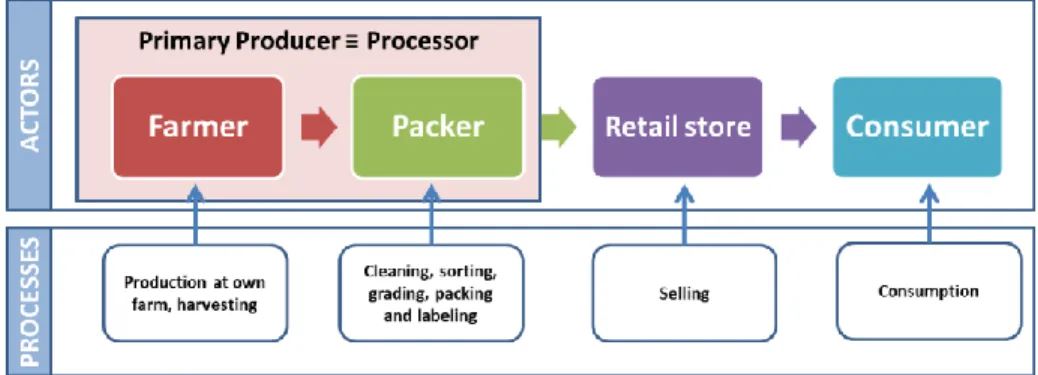1
“To myself, for the great effort.”
2
Table of Contents
Preface ... 4
Abstract ... 6
GENERAL INTRODUCTION ... 8
1.1 Introduction to the research problem ... 8
1.2 Problem Statement... 9
1.3 Research Questions ... 11
1.4 Practical Implications ... 13
1.5 Dissertation Organization ... 14
CHAPTER 2 ... 16
FUNDAMENTALS OF FOOD TRACEABILITY ... 16
2.1 Introduction to Traceability ... 16
2.2 Traceability Definition ... 17
2.2.1 Tracking and Tracing ... 17
2.3 Traceability in the Food Sector ... 18
2.3.1 Food supply Chain ... 18
2.3.2 Unique identification of lot ... 20
2.4 Traceability Benefits versus Disadvantages ... 24
2.5 Technologies for Products Identification ... 26
CHAPTER 3 ... 31
FOOD TRACEABILITY MODELS: A STATE OF THE ART OVERVIEW ... 31
3.1 Introduction ... 31 3.2 Regulatory Overview ... 32 3.3 Scientific Literature ... 36 3.3.1 Mathematical Models ... 36 3.3.2 Information Models ... 37 3.3.3 Ontological Models ... 40
3.3.3.1 Food ontologies for the domain of healthcare, diet and nutrition ... 41
3.3.3.2 Food ontologies for specific area of the food domain ... 43
3.3.3.3 Food ontologies for the traceability domain ... 43
3.3.3.4 Methodologies for representing the knowledge related to food traceability domains ... 44
3.4 Discussions... 45
CHAPTER 4 ... 48
EFFECTIVE TRACEABILITY MANAGEMENT: THE GLOBAL TRACK&TRACE SYSTEM FOR FOOD . 48 4.1 Introduction ... 48
4.2 The Global Track&Trace (T&T) System for Food ... 49
4.2.1 The Food Track&Trace Building Process ... 49
4.2.1.1 STEP 1: Food Supply Chain analysis ... 51
4.3.1.2 STEP 2: Food Supply chain modeling ... 59
3
4.3.1.3 STEP 3: Data Collection ... 65
4.3.1.4 STEP 4: Data modeling ... 67
4.3.1.5 STEP 5: Generation and Customization of the web-based application for the traceability management. ... 68
4.3 The Food Track and Trace Ontology (FTTO) ... 69
4.3.1Background: Ontologies and OWL ... 70
4.3.2Ontology description ... 70
4.3.2.1 FTTO Building process ... 71
4.3.2.2FTTO conceptualization ... 73
4.3.2.3 Ontology basic elements ... 74
4.3.2.3.1 Agent Module ... 74
4.3.2.3.2 Food Module ... 75
4.3.2.3.3 Process Module ... 77
4.3.2.3.4 Service Product Module ... 79
4.3.3. Ontology querying ... 80
CHAPTER 5 ... 83
EFFECTIVE TRACEABILITY MANAGEMENT: FUNCTIONING PRINCIPLES AND CASE STUDIES ... 83
5.1 Global Track & Trace System Working Principles ... 84
5.1.1 Traceability of Incomings Lots ... 85
5.1.2 Traceability of Storage ... 89
5.1.3 Traceability of Operations executed on Lots ... 94
5.1.4 Traceability of Shipped lots ... 98
5.2 Adaptation of the general framework ... 99
5.2.1 Traceability of Fruit and Vegetables ... 99
5.2.1.1 Traceability of fresh fruit ... 101
STEP 1: Analysis of the supply chain of fresh fruit and vegetable ... 101
STEP 2: Modeling of the supply chain of fresh fruits and vegetables under own production ... 102
STEP 3: Data collection ... 103
STEP 4: Data modeling ... 105
STEP 5: Generation of the web application ... 107
5.2.2. Traceability of frozen vegetables ... 111
STEP 1: Supply Chain Analysis of Frozen Vegetable for the Company under study ... 111
STEP 2: Supply Chain Modeling ... 113
STEP 3: Data collection ... 116
STEP 4: Data modeling ... 119
STEP 5: Generation of the web application ... 122
5.2.2 Traceability of meat and meat products ... 125
STEP 1: Analysis of the meat supply chain ... 125
STEP 2: Modeling of the meat supply chain ... 127
STEP 3: Data analysis ... 131
STEP 4: Data modeling ... 133
STEP5: Traceability of Meat Supply Chain Web Application ... 142
RESULTS AND CONCLUSIONS ...146
List of Figures... 150
List of Tables ... 153
4
Preface
This thesis presents the results of the research activities carried out over the three years of the PhD course at the Mechanical Department of the University of Calabria (Italy) and at the Computer Sciences Department of the Universidad Pontificia Comillas (Spain). The PhD course focuses on the Design of an Effective Traceability System.
In particular the PhD focuses on the methodological approach followed in order to model and develop a traceability system aimed at improving the supply chain management of the companies operating in the food sector. The system itself can assist users in case of food outbreak diseases and in case of recall procedures through the identification of the most relevant information for the problem resolution. By implementing the developed Global Track &Trace System at a high level of the supply chain, the competitiveness, and the effectiveness of the supply chain itself can be improved.
This thesis is a result of a multi-disciplinary research, which involves three main subjects: Logistics, Transformation and Production. The focus of the thesis is based on the Food Sector. The research work has been co-founded with the support of the European Commission, the European Social Found and the Italian Region of Calabria. Consequently, the focus and the domain of the thesis were mainly oriented by a deep analysis of the regional context of Calabria in order to identify some solution form improving the effectiveness and efficiency of the companies operating in the region itself. The results of the context analysis highlighted the presence, in Calabria, of a relevant number of companies operating in the agro-food sector. The agro-food sector, in fact, involves the majority of the Small and Medium Enterprises (SMEs) located in the region. To this end, the main aim of the research work is the improvement of the supply chain management of these companies and the quality and safety of their outputs, through the maintenance of information about products at each step of the supply chain. The final result of the research consists in such innovative system for products traceability, particularly devoted to the maintenance of traceability in the food sector.
Currently, traceability is one of the main issues attracting the attention of private companies and public authorities because of its relevance in the maintenance of food quality and safety. The implementation of an appropriate traceability system, able to guarantee the continuous monitoring of the flow of products and of information and capable of facilitating the process of products certification, is strategically essential to achieve continuous quality improvements.
After the serious incidents that invested the food sector (BSE, dioxin contamination, blue mozzarella, Escherichia Coli diffusion, etc.), several institutions have promoted the introduction of control systems able to effectively trace not conforming goods and to identify the factors of risks which compromise food quality and hygiene and create dangerous conditions for human health. Moreover, although important regulations have been introduced to define the general principles of food quality and safety, the food sector is continuously exposed to risks and dangers. To reduce this exposure, the widespread adoption of efficient traceability systems is desirable.
The ability to track and trace every single unit of product depends on the supply chain traceability systems, which in turn depends on the internal data management system and on
5
the procedures for the information transmission among the different actors of the supply chain.
To this end, the research objective of this work is to develop a general framework for the traceability of food products, able to support quality and safety control. The solution adopted for the information management is generally applicable, which means that it meets the requirements of different types of food industries. The model can be applied in real-life situations that might benefits from the traceability solution.
6
Abstract
The evolution of the information technologies and their impact in human life promotes an increasing demand of reliable information when security and safety plays a primary role. Nowadays, food traceability represents one of the main concerns for public authorities and industries. In particular, traceability has become a critical part of the agro-food industry. The aim of the agro-food traceability is to allow the full monitoring of a product in the supply chain and to trace the history of a good from the producer to the consumer. It is therefore a preventive instrument of quality and safety management. The proposed research study is oriented to the definition of a new Global Track and Trace (T&T) System in which the entire world’s partners of a product’s supply chain are involved. In this system the functionalities of a conventional traceability system are combined with the functionalities of a Food Ontology for the traceability domain. The Food Ontology is defined in order to solve the issue of information-systems integration and standardization. The idea is to recover and to have available in a short time period all the relevant information about a product. This is a critical issue especially in case of foodborne outbreak and food crisis. The proposed framework can be a strategic approach for information and process management, also at the farm level. The model permits the Supply Chain optimization and the food quality management. The system itself can be a valuable tool for assuring customers and promoting the liability of the production process, along with the compliance with the regulatory standards aimed at defining quality and safety requirements.
Keywords: Food Supply Chain, Tracking, Tracing, BPMN, Information system,
7
Abstract
L’accresciuto interesse per la tracciabilità dei prodotti persegue la duplice finalità di rispettare le normative vigenti e di accrescere la fiducia dei consumatori migliorando sia l’immagine delle aziende sia dei prodotti da essi venduti. Non secondaria è la possibilità di compiere interventi rapidi e mirati capaci di ridurre i rischi di diffusione di intossicazioni alimentari derivanti da prodotti contaminati potenzialmente pericolosi per la salute dei consumatori. Dunque, un efficiente sistema di tracciabilità deve essere in grado di garantire la tracciabilità e la rintracciabilità dei prodotti. Il termine tracciabilità fa riferimento alla capacità di seguire un prodotto lungo la catena di fornitura, registrando i dati relativi a ciascuna fase produttiva, mentre la rintracciabilità è definita dal Regolamento 178/2002 della Comunità Europea come “la possibilità di ricostruire e seguire il percorso di un alimento, di un mangime, di un animale destinato alla produzione alimentare o di una sostanza destinata a far parte di un alimento attraverso tutte le fasi della produzione, della trasformazione e della distribuzione”. Negli ultimi anni numerose iniziative sono state poste in atto dal punto di vista normativo per il mantenimento della tracciabilità dei prodotti alimentari. Come conseguenza di tali iniziative, differenti sistemi di tracciabilità sono stati proposti e implementati in diversi Paesi. Tuttavia, i recenti “food accident” hanno mostrato i limiti di questi sistemi e l’incapacità degli stessi di legare tra loro le diverse informazioni registrate lungo la supply chain con un conseguente aumento dei tempi per l’ottenimento dei dati necessari a fronteggiare le crisi derivanti da intossicazioni alimentari. Nasce quindi l’esigenza di sviluppare e proporre nuovi sistemi di tracciabilità più efficaci, in grado di registrare tutte le informazioni sull’intero ciclo di vita di un prodotto alimentare. Lo studio di ricerca proposto in questa tesi di Dottorato è orientato alla definizione di un nuovo Global Track and Trace (T&T) System per la tracciabilità globale dei prodotti in cui sono coinvolti tutti gli attori che partecipano alla realizzazione di un prodotto alimentare. Il sistema è stato ottenuto combinando le funzionalità di un sistema di rintracciabilità convenzionale, ottenuto mediante la modellazione dei processi di business e dei dati coinvolti nell’intera filiera, con le funzionalità di una Ontologia opportunamente definita per rappresentare per il dominio di conoscenza della tracciabilità alimentare. Il quadro proposto può essere un approccio strategico per la gestione dell'informazione e dei processi. Il modello consente l’ottimizzazione della supply chain e la gestione e assicurazione della qualità degli alimenti.
8
Chapter 1:
General Introduction
1.1 Introduction 1.2 Problem Statement 1.3 Objectives 1.4 Practical Implications 1.5 Dissertation Organization1.1 Introduction to the research problem
The increasing interest in food traceability directly interfaces with customer demands for food quality and safety. Customers are more and more exigent and they require the governmental control of the whole food system. As a consequence, different types of traceability systems are emerging as a result of regulatory interventions, at an industry-wide level, and as a competitive strategy at the level of individual supply chain. Moreover, the key issues frustrating the job of food safety agents are the inability to link food chains records, inaccuracy and errors in records and delays in obtaining essential data. The recent case of E. Coli in Germany is an example of the strong reaction of the market to a food crisis. In such a contest, the main goal of this research work is the development of a general framework for the traceability of food products able to support quality and safety control. Through the development of a global traceability systems it is possible to enable more targeted recalls, to easily identify the product’s origin and consequently to limit the product recall only to the products actually affected by contamination (Pouliot and Sumner, 2009). A new traceability framework can be defined combining the advantages of an information system for food tracking with the advantage of an ontological model in which relations between concepts are standardized. This system can help governmental authorities in case of food outbreak disease and offer more information to the customers on the products they eat.
9
1.2 Problem Statement
Traceability systems are emerging in various guides, as result of both regulatory and industry initiatives.
A traceability system should satisfy three key functions (Golan et al., 2004; Hobbs et al., 2005, 2002):
It should efficiently allow the trace-back of products and inputs when a food safety or herd health problem occurs. In such a case, efficient and timely trace-back could limit the size of product recalls and limit the number of people exposed to tainted food, thereby limiting human-health impacts, minimizing productivity losses from illness, etc.
It should reduce information costs for consumers by identifying credence attributes through the labeling of environmentally friendly production practices, or assurances about feed, other ingredients or production practices. In this case the traceability system is directly connected with the quality system of the company.
It may be considered as a means of strengthening liability incentives to produce safe food.
Potential of traceability systems and the numerous advantages that can be obtained through its implementation have been well documented in literature (Lo Bello et al., 2005; Moe, 1998). Figure 1 provides a visual representation of the potential public and private benefits from traceability, with the size of the circle representing the relative size of the potential benefits (Sparling et al., 2011). Benefits can accrue to the public in terms of more rapid and accurate response to food safety events but also in providing consumers with more information on the origin of food. Business stands to realize opportunities through reduced recall scope, greater quality assurance, and values capture and supply chain efficiency.
Despite multifaceted potential benefits, the operational conditions of current traceability systems are kept at bare minimum merely to fulfill legal requirements. Particularly Small and Medium Enterprises (SMEs) do not use traceability systems or use paper based systems due to the limited scale of their operations, the necessity of heavy investment and the nature of their manufacturing process (Nishantha et al., 2010). Meeting the traceability standard set by an industry organization or by government regulation generally affects the cost of production per unit of food. In addition, many barriers hinder the successful implementation of traceability, the major are: (i) necessity of costly investments, (ii) reluctance to change, (iii) lack of skilled staff to handle advanced systems and (iv) limitation of existing traceability systems. Moreover, tracing and tracking capabilities are crucial to confine the reaction to possible hazards and reduce the recovery cost (Bechini et al., 2005).
Nowadays, recent food safety incidents (e.g. dioxins in animal feedstuffs in Belgium, E. Choli in German) have demonstrated that traceability is a “buzz word” with regard to food: traceability systems have been shown to be weak or absent and hence slow or unable to assure consumers the food safety. In such cases, food recalls or warning have been applied to all suppliers, even to the supplier of products that did not contributed to the contamination. This is one of the main issues of traceability that can be easily solved through the introduction of a global traceability system capable to immediately identify, in case emergency, the origin of a food disease and to enable more targeted recalls. To take the
10
today’s requirements on food quality for health care into consideration, additional data that are not strictly necessary to traceability must be stored. For instance, for a cooking activity, oven temperature and humidity can be considered as important parameters in case of hazard. For a cultivation activity, operations on the parcel are fundamental to trace the proximity of the land of cultivation to a source of pollution.
Figure 1 - Benefits from Traceability
Source: An Appetite for Traceability: results from OnTraceability Conference 2011 Regarding to the products identification mechanisms, today a variety of lot code markings and systems exists for products identification. Moreover, while these have merit, they do not link across the life cycle of the world’s food supply. Generally information is recorded into data centers internal to the company connected in order to create a distributed database. With proper authority and access, agencies can query the global network of data centers to investigates and respond to food contamination concerns at Internet speed. In addition, when some problem occurs and the database is disconnected from the network, the traceability is lost. For this reason is highlighted the importance of contain all the information on the life of a products in its label.
In recent years the traceability of food products has attracted the attention of many researchers for several reasons (Jansen-Vullers et al., 2003): first traceability, according to the Regulation of the European Community N. 178/2002, has become a legal requirement within the European Union from January 1, 2005 (European Commission, 2002); secondly, food companies tend to view traceability as a strategic tool needed to increase consumer confidence and improve the both image of the company and of a specific product.
Moreover, currently consumers have no access to the information on the real origin of products, the activities in which the products were involved and the operators who manipulated it. Many initiatives have been started in the area of food traceability in the last decade and several authors have been interested in the development of food traceability systems (Bechini et al., 2008; Bevilacqua et al., 2009; Jansen-Vullers et al., 2003; Regattieri et al., 2007; Ruiz-Garcia et al., 2010; Thakur and Donnelly, 2010; Thakur and Hurburgh, 2009; Thakur et al., 2011a, 2011b; Verdouw et al., 2010). Despite the numerous efforts for developing effective traceability systems, current results obtained reveal some critical limitation of existing traceability systems (Bechini et al., 2005). Successful implementation
11
of traceability systems requires elevate investment costs, staff training and global legal requirements.
The development of a traceability system has to face with other issues, especially in case of continuous transformation processes. Many of the difficulties in the phase of implementation of traceability systems within manufacturing systems are related to the determination of the traceable product unit size. Some of the key areas of difficulty are (i) continuous and batch processing and (ii) the transfers between such processes within the manufacturing system (UK Standard Organization). For instance, in case of handling of bulk products (sugar, salt, glucose syrup, flour), even where goods are delivered with clear batch identification in a tanker, they may be emptied into a single silo and mixed with earlier deliveries, so onward traceability may not be maintained. Silos also have dead zones in filling and emptying, which can cause the blending of successive batches. To this end, information about all the products used in the production process must be maintained, also referring to water used in food processing and manufacture.
1.3 Research Questions
Robust and effective systems/frameworks to provide “farm to fork” traceability of food are not present within the food industry at the moment, except in some very specific areas (e.g. beef and some retailer chains for meat and produce). We think that a Global Track and Trace (T&T) System is required to solve the problems stated in the previous paragraph. Following this line, the study is oriented to the definition of a new Global T&T System in which the entire world’s partners of a product’s supply chain are involved. In this system the functionalities of a conventional traceability system are combined with the advantages of Ontologies.
The aim of the study is twofold and it consists of:
1) Developing a traceability system prototype in a cost and user friendly manner in order to facilitate the integration of information across the entire supply chain and to ensure consumer trust and compliance with legal and quality standard;
2) Facilitating the identification of foodborne outbreak disease.
In the development of the general framework, the following questions have been considered: (a) Internal systems for registrations. Traceability requires data from systems and
registrations which have initially not been set up for products traceability but for other purpose, such as sales, purchasing, production, and laboratory management. It is necessary to consider interactions between traceability and other management systems. Within food manufacturing it is common to see traceability systems used alongside HACCP to provide verifiable documentation for monitoring the critical control points and allows remedial action to be taken if product falls below quality. Some manufacturers consider their traceability systems (dominantly linked to process control) to be separate to HACCP (linked to quality management). But others consider traceability and HACPP to be irretrievably intertwined as part of a product quality management system. These may not necessarily be opposing views, but represent different viewpoints related to how the systems have been implemented in practice.
12
(b) Lack of standardization. From the regulatory point of view, actors positioned within different context (UE, Japan, USA, etc.) deal with different implementations of products responsibility and liability. The regulatory framework for food traceability, in fact, is wide and diversified. From an information perspective, another important bottleneck is represented by the lack of standards for information encoding and exchange.
(c) Financial obstacle. The introduction of an information system for food traceability requires initial investments that represent a financial obstacle above all for Small and Medium Enterprises (SMEs). Many complex technologies only lie within reach of the big players. For the small players in the field (e.g. the farmer) these technologies are financially not feasible. Nevertheless, the large majority of companies involved in food chains are SMEs and consequently simple tools need to be available for their use.
(d) Implementation issues. The implementation of T&T must not be underestimated because it requires some changes in the way of working. All employers working with the T&T system must receive proper education and everybody should know the importance of extended registration.
(e) Privacy and rights problems. The flow of products lots along the supply chain is associated with the information exchanges among responsible actors and possibly third-party organizations. Because of its significance for the concerned enterprises, traceability and quality information must always be transmitted in a secure and reliable way. To this end, integrity requirements must be considered such as (i) access and user rights, and (ii) protection of privacy, autonomy, commercial interest and legal protection in case of responsibility.
On the base of the above-mentioned questions, a new Global T&T Framework for Food is developed taking into consideration the following assumptions:
The traceability systems should connect easily with other systems that are pre-sent inside the company. Actors in the Supply Chain have their own Enterprise Resource Planning (ERP) and quality systems: in such a context, a tracking-tracing infrastructure must cooperate with all systems and infrastructures present in the company.
The system must be easy to understand. A simple way of registration with bar code or RFID may increase the level of acceptance and decrease the possibility of mistakes (lots code must be automatically generated by the systems).
Interchange standards are required to enable interfacing between enterprise systems. For a successful information exchange in the chain, we need to solve the issue of information-systems integration and standardization (Beers et al., 1994). Any enterprise must be able to connect to the information infrastructure so as to exchange information in the supply chain. To ensure system interoperability and communication between the different actors, it is necessary to identify a standard for encoding information not only for common companies operating in the single chain, but for all reference operators (De Cindio et al., 2011a).
Agreements can be made on the exchange of information. In addition, the in-creased cooperation between the constituting organizations represents a possible way of dealing with uncertainties in the Supply Chain.
The global traceability system should be developed and maintained with reduced costs. Modern communication technology can help SMEs in the development of their
13
internal traceability system. To this end, access to information technology and Internet may need to be facilitated.
Such a kind of communication, especially when different enterprises are involved, can be regarded as an business transaction. For this reason, the adoption of e-business protocols becomes both appropriate and convenient. Electronic Business Extensible Markup Language (EbXML) can help in the phase of information exchange (Olivier et al., 2009). The ebXML specification provides organizations with a common, extensible, and automated method of exchanging business messages, conducting trading relationships, communicating data using common terms, and defining and registering business processes (ebXML official website). In addition, ebXML is a promising standard also for e-government distributed applications: in this perspective, monitoring activities from official organizations would be made easier by a common communication infrastructure among the actors taking part to the traceability system.
Summarizing, the main goal of the proposed research work is the creation of a “re-al” and “working” Global Track&Trace System for Food where all the actor in the chain are able to keep and share information on products and processes.
1.4 Practical Implications
The proposed framework can be a strategic approach for information and process management, also at the farm level. The model will lead to the Supply Chain optimization and the improvement of the food quality management.
The integration of the Global T&T Food System with the Food Track &Trace Ontology is a strategic approach that can help in the traceability maintenance. Through the final system, each food supply chain operator can:
guarantee the origin and the quality of a food product; assure the compliance with regulation;
improve Logistics;
improve inventory management; manage the whole products lifecycle.
In addition, recorded data can be used for several analyses such as for the definition of: type and quantity of cultivation (plant, animals or fresh) per Locality or Region; type and quantity of cultivation per period or year;
land surface availability to be allocated to a particular product; level of activities of a particular Locality/Region/Country; previsions;
recommendations.
Finally, data and time information recorded in each production step help in identifying non-compliance in the case of storage. The system, in fact, can be used in order to avoid food fraud such as off-season sales and certify the total quality of the product.
14
1.5 Dissertation Organization
The PhD work is organized in five chapters. Chapter 1 defines the Problem Statement, enumerates the different research questions and introduces practical implication of the final research work. Chapter 2 provides a brief overview on the main concepts related with food traceability, focusing on benefits and disadvantages that can be obtained through the implementation of a traceability system and introducing standards and technologies that can be used for the maintenance of food traceability at the company level and the level of the entire supply chain. Chapter 3 passes through the description of several research works, as they run through the literature, according to the methodology or scientific approach they propose. The initial search identifies a huge number of references, which were reduced on the base of contents and quality. In particular two different parts have been analyzed: (i) regulation, recommendation, and practical guides; (ii) scientific literature. The analysis of the scientific literature highlighted the presence of three main categories of works, each of one devoted to the definition of Mathematical models, Information model and Ontological models for the traceability management. This PhD thesis comes in help of such research shortages by proposing a design methodology for the development of an effective traceability system obtained combining the advantages that can be obtained through the implementation of some informative systems with the advantages that can be obtained using ontologies defined for modeling the traceability domain of food.
The main results of the research activity are presented in Chapters 4 and Chapter 5. Chapter 4 describes the design and development of the Global Track&Trace System for Food. In particular, the first section of Chapter 4 describes the methodological approach followed for the design and development of the Track and Trace Information System, with a particular focus on the general architecture that characterize the system. Successful cooperation within chains requires common vocabulary for inter-organizational communication, and requires the issue of information-systems integration and standardization to be resolved. To this end, in the second part of Chapter 4 the Food Track &Trace Ontology (FTTO) is presented, with the main aim of describing classes and relationship between classed. The ontology definition helps in the semantic research in case of food contamination and product recall.
Chapter 5 presents some case studies related to the application and adaptation of the Global Track& Trace Framework. Practical examples allow understanding the use of the methodologies followed for the Global Track and Trace System. In addition, the first section of Chapter 5 the working principles of the Global Track&Trace Systems are explained.
Analyzing the core stages of the research work, the work progresses through the following steps:
Design and Development of a Web Based Track & Trace Information System. The
general framework is obtained through the definition of a T&T Information System. The development of the information system requires the modeling of business processes and associated data results. In the proposed framework the supply chain has been initially modeled according to the BPMN standard. BPMN allows for reconstructing patterns of process or the Business Process Diagram (BPD) by means of graphs or networks of objects. These objects represent the activities of the process and they are connected by control flows that define logical relationships, dependencies, and the execution order. From the modeling and the analysis of product processes in the chain, we want to become aware of data to be
15
recorded. A general data model is proposed enough flexible for developing the strategy of traceability and open to incorporate new future features to be taken into account. The data modeling and management approach is achieved through the creation of a web-based system. The software tool utilized directly generates a web application model that assures the connection to each operator of the supply chain. Each agent stores the data of the product worked and collaborates with the other neighbor agents of the track chain by making available all information necessary for traceability. The created framework and its corresponding application is an important tool for management of all the information related to the traceability process.
Food Ontology Definition. A new Food Ontology is developed for the domain of food
traceability. To enable information sharing, data and the way they are organized should be standardized and their meaning and carrying semantics should be commonly agreed by the different operators along the food supply chain (Salampasis et al., 2008). Both products and processes may form key components (known technically as core entities) in a traceability system with information stored in relation to each. The new Food Ontology is defined to set up a traceability semantic model in order to reuse the information resources in the process of tracing and promote the accuracy and efficiency of information management. The quality ontology proposed by (Kim et al., 1995) represent, at the moment, the base for a lot of research work in the field of traceability. Based on the ontology, a semantic research can be made and it can help in the phase of products tracing.
16
Chapter 2
Fundamentals of Food Traceability
2.1 Introduction to Traceability 2.2 Traceability Definition
2.2.1 Tracking and Tracking 2.3 Traceability in the Food Sector
2.3.1 Food Supply Chain definition 2.3.2 Unique identification of lot 2.4 Traceability benefits versus disadvantages 2.5 Technologies for Products Identification
2.1 Introduction to Traceability
This section provides a brief overview on the main concepts related with food traceability, focusing on benefits and disadvantages that can be obtained through the implementation of a traceability system and introducing standards and technologies that can be used for the maintenance of food traceability at the company level and the level of the entire supply chain.
A well-organized supply chain should have the ability to reconstruct the history of each product and follow the food through the various processing steps, identifying and recording the materials used and the operators involved, correctly combining this information to the single product package introduced in the market.
This result can be conveniently achieved if each company of the supply chain adopts an internal system for controlling and recording information (“internal traceability”) and if transitions between the actors are regulated and managed in a coherent and shared form (“external traceability”). In this way is possible to trace the path followed by a food product that moves from “farm to fork”. A traceability system requires consequently the definition of
17
internal system for recording information and facilitating the identification of the product’s origin and the utilization of particular technologies able to maintain the connection between products and related information.
2.2 Traceability Definition
Several definition of Traceability has been specified in different regulatory standards. The International Standard Organization defines traceability as the “ability to trace the history, application or location of an entity, by means of recorded identifications (UNI EN
ISO 8402: Sistemi Qualità. Gestione per la Qualità e assicurazione della Qualità - Termini e definizioni, 1995).
In the food sector, the Codex Alimentarius Commission introduced the term “traceability” in 1999 to define the “ability to trace the history, application or location of an entity by means of recorder information. In Europe, the regulation (EC) 178/2002 represents the main regulatory reference for the food legislation on food traceability and safety. The Regulation EC 178/2002 defines traceability as “the ability to trace and follow food, feed, and ingredients through all stages of production, processing and distribution” (Art. 18, EC.178/2002).
In the scientific literature, (Moe, 1998) defines traceability as “an ability by which one may track a product batch and its history through the whole, or part, of a production chain from harvest through transport, storage, processing, distribution and sales, or internally in one of the steps in the chain, for example the production step.
The maintenance of traceability is a complicated and expensive process, especially with regards to processed food. In case of processed foods, in fact, different lots of various raw materials are combined into several production batches typically distributed in various points of sale (Hu et al., 2009). Hence, data to record must include information on products and on processes that operate on products (such as transport, transformation or combination). Kim et al., (1995) state, in fact, that a traceability system must be able to track both products and activities operate on products. This goal can be reached through the implementation of an efficient traceability system supported by appropriate architectural solutions (Bechini et al., 2008). In particular, a traceability system must support information tracking and tracing. The meaning of tracking and tracing is defined in the next sub-paragraph.
2.2.1 Tracking and Tracing
Traceability is obtained through the combination of two different processes: tracking and tracing (Figure 2). These terms are often used in an interchangeably way even though they have different meanings. Tracking is the informative process by which a product is followed along the supply chain keeping records at each stage, from the production to the transformation and distribution process. Tracing is the reverse process of tracking. Tracing is defined as the ability of reconstructing the history of a product, identifying its origin through the complexity of resources involved in its lifecycle. While the tracking process operates in order to record the important information at each step of the supply chain, the tracing process represent the ability of identify the origin of a product through the analysis and elaboration of the information previously recorded by each actor involved in the chain.
18
Figure 2 - Tracking and Tracing
In the context of this PhD thesis, the term traceability system is used for identifying the informative system used to assist in the process of information tracking and tracing.
The operations required by a traceability management system can be divided into two main activities, which refer to internal traceability and supply chain traceability. The internal
traceability is realized by internal procedures, different for each business, that allow tracing
the origin of products involved in the production process, process operations and food destination. The food supply chain traceability or external traceability is guaranteed by the integration and coordination of the tracking procedure adopted by each operator of the chain, and represents the ability to follow the path of a specific unit of product along the production chain. It is generally obtained through the linkage of the different traceability systems internal to the company belonging to the food supply chain to each other.
In particular, the definition and implementation of a food supply chain traceability system depends on both the supply chain and the relationships between the various partners that collaborate in the production process. Manufacturers, distributors, authorities and consumers should be able to track and identify food and raw materials used for food production to comply with legislation and to meet the requirements of food safety and food quality (Ruiz-Garcia et al., 2010). This result can be conveniently achieved if each company along the supply chain is able to adopt a system of internal control and recording (internal traceability) information and if transitions between actors are regulated and managed in a coherent and shared form (De Cindio et al., 2011b).
2.3 Traceability in the Food Sector
This section introduces the concepts of food supply chain and traceable resource unit or lot that are required for the traceability maintenance.
2.3.1 Food supply Chain
The Food Supply Chain (FSC) is a complex structure in which are involved several actor that contribute to the production, distribution, marketing and supply of food products.
19
On the basis of the definition provided by the Food Traceability Handbook (Revision Committee on the Handbook for Introduction of Food Traceability Systems, 2007) five basic actors are involved in a typical FSC. These actors are: the primary producer, the processing company, the distributor, the retailer and the transporter or third part carrier. Each actor performs a specific task. The primary producer, such as the fisherman, the grower or the farmer, is devoted to the production of raw material and ingredient that are successively transformed by the processing companies or factories; the transporter moves the products from one actor to another; the distributor handles the food commodities; the retailer sells the food directly to the consumer. The presence of these actors highlights that the concept of food chain is extended both to the individuals upstream and downstream in the supply chain.
A typical FSC differs from the other supply chain because of the perishability that characterizes food product. As specified by Nishantha et al., (2010) the time windows in which food products moves from the raw material producer until the consumer remains relatively shorter in FSC. Food products, in fact, are extremely time critical and, by their nature, they are characterized by a short shelf. Food products are perishable and the harvesting means, transformation processes, transporting ways, and storage conditions condition their shelf life. This aspects, along with the wide variety of food products, contribute to making more difficult the design, implementation, and management of an efficient system of traceability (De Cindio et al., 2012a).
In Italy, the food sector is formed by four main subsectors:
Agricultural Industry (which includes agriculture, livestock farm and aquaculture); Food Industry (for food transformation and conservation);
Food Distribution Sector;
Commercial Catering and Restaurants.
Figure 3 shows a typical agri-food supply chain. As before mentioned, the food supply chain can assume different configuration according with the number of actors which collaborate for the definition of the final product and of the number of processes operated on primary food commodities and processes food before they are introduced into the market. Two actors are always present in the food supply chain: the primary producer and the consumer. When the activities of production, processing and sales are carried out directly from the farm, it refers to the so-called short chain. Typical examples are the co-operatives of farmers cultivating fruits and vegetables that they directly sell them to the final customer in bulk or packaged without any commercial intermediary. Long food supply chains refer to complex agro-industrial systems in which the food, before reaching the consumer, passes through different stages of processing, transportation and distribution that are usually managed and controlled by different actors.
Processes operated in a generic food supply chain include agricultural processes, food transformation processes and other business processes of support such as procurement, inventory management, packaging and labeling, shipping, transportation. The field of agricultural and food transformation processes is wide and diversified. Agriculture is the process of producing food, feeding products, fiber and other desired products by the cultivation of certain plants and the raising of domesticated animals (livestock) or of fish and shellfish. The practice of agriculture is also known as farming. The outputs of the agricultural processes in the context of this research work are called primary food commodities.
20
Figure 3 - Representation of the product flow in a typical agri-food supply chain
Transformation processes refers to the practice of Food processing. For definition, food processing includes the methods and techniques used to transform raw ingredients into food for human consumption. Food processing takes clean harvested or slaughtered and butchered components and uses them to produce marketable food products. Transformation operations are critical for the traceability maintenance because they require in input different products belonging to different lots for producing a particular processed food that are combined in a single final product. Food which undergone a transformation process is called processed food.
A vast global transportation network is required by the food industry in order to connect its numerous parts. These include suppliers, manufacturers, warehousing, retailers and the end consumers. Transportation’s operation can be done in different way and using different means of transportation, involving third part carries. Transportation and storage are critical phase for products quality and safety because of the perishability that characterize food. Typical parameters to be monitored are humidity and temperature.
2.3.2 Unique identification of lot
The batch or lot definition is a fundamental step when constructing traceability
systems
. Unique identification and traceability in any system hinges, in fact, on the definition of what is the batch size, or using the terminology used by Kim et al., (1995), the traceable resource unit (TRU) (Moe, 1998).A Traceable Resource Unit is defined by the GS1 Standards as “any item upon which there is a need to retrieve predefined information and that may be priced, or ordered, or invoiced at any point in any supply chain” (GS1 Standards Document, 2010).
The identification of the batches is necessary at least in two fundamental stages: at the beginning of each process and at the end. At the beginning of each process, it is necessary to identify the different batches of incoming raw materials, semi-finished products or auxiliary materials (additives, flavorings, spices, etc.). At the end of each process, instead, it is necessary to identify and distinguish the different batches of semi-finished products that are
21
generally bound to other companies for further processing, and/or the batches of finished products that are sent the market and bought by the final consumer. In the above-mentioned moments the batches must be recognizable and uniquely identifiable using the most appropriate tools (codes, alphanumeric codes, barcodes, tags, etc.) in order to define the lines of responsibility and to identify all those individuals who have contributed to their formation. The identification of batches and elements to trace depends on the process’ stages under analysis. The definition of TRU is a complex task especially in case of continuous processes. According to (Moe, 1998), in fact, defining the TRU for continuous processing can be challenging. It may depend on how the raw material TRU was received and or on a change in processing conditions such as the clean out process for production equipment. One of the major challenges in regards to establishing whole chain traceability is the transformations that TRU goes through throughout its life cycle (Schwägele, 2005).
Transformation can be described as an operation, which happens between different traceable resource units. Transformations occur when products move from upstream to downstream through the supply chain. TRU transformations can occur when products belonging to different TRUs are mixed, joined, split-up, added or converted into another TRU within the company or between companies in a value chain (Donnelly et al., 2009).
The composition of the batches represents a critical point in determining the accuracy of the traceability system.
Because a lot is characterized by products obtained under homogeneous conditions by location, type and date of treatments, different types of lot can be defined at each step of the production process. As defined by the (Revision Committee on the Hanbook for Introduction of Food Traceability Systems, 2007):
the lot formed at the production stage is sometimes called a production lot. the lot that is formed when processing a product is sometimes called a product lot. the lot that is formed when shipping is sometimes called a shipping lot.
there are cases when a new lot is formed when receiving lots are rearranged at the distribution stage. This is sometimes called a distribution lot.
As defined by the Ministry of Agriculture, Forestry and Fisheries of Japan in the Guidelines for Introduction of Food Traceability Systems (Ministry of Agriculture, Forestry and Fisheries of Japan, 2003) the lot behavior can be modeled by the following 6 activity patterns, also described by (Bechini et al., 2008) .
Lot integration: A number of lots are integrated into a unique lot, and a combination lot is formed (Figure 4). Real examples of lot integration are mixing and packing.
22
Lot division: A lot is split into a number of lots (Figure 5). Real examples of lot division are cutting and splitting.
Figure 5 – Division pattern
Lot alteration: The Lot Alteration pattern describe the condition by which a new lot is generated from a lot by an alteration activity (Figure 6). Real examples of lot alteration are heating, freezing, and drying.
Figure 6 - Alteration Pattern
Lot movement: A lot is moved from one storage site (actual site) to another
(destination site) internally to a single company (Figure 7). Information on storage conditions is fundamental at this stage because of the perishability feature of food.
Figure 7 - Movement Pattern
Lot providing: An actor (supplier) of the supply chain provides another actor (client)
with a lot (Figure 8). The provider generates a new lot and creates an association between the pre-providing lot and the post-providing lot.
23
Figure 8 - Provision or Supplying Pattern
Lot acquisition: An actor (client) of the supply chain acquires a lot from another
actor (supplier) (Figure 9). The client can generates a new lot and creates an association between the pre-acquisition lot
Figure 9 - Acquisition Pattern
From a dynamic point of view, the lot integration, lot division, lot alteration and lot movement can be modeled as a generic Lot transformation from X lots to Y lots (Figure 10). Thus, a lot division into X separate lots, and the integration of Y lots into a unique lot are represented as a transformation of one lot into X lots and of X lots into one lot, respectively. Unlike the transformation pattern, in the acquisition and providing patterns the incoming and outgoing lots have distinct associated responsible actors.
Figure 10 -Transformation Pattern
The definition of lots is a fundamental step for the traceability management and it requires the linkage of information on products and processes.
24
2.4 Traceability Benefits versus Disadvantages
The advantages that can be achieved through the implementation of a traceability system concern both internal organization of companies and external aspects related with the supply chain management. Some authors, as Golan et al. (2003), have identified in the following aspects the reasons behind the adoption of traceability systems:
Improvements in the management of the entire supply chain
Products differentiation and creation of added value products through the guarantee of quality assurance and security;
Easy identification of not-compliant products.
Advantages pursued with the implementation of external traceability systems are directly related with benefits that can be gained from the adoption internal traceability systems. According to Moe (1998), the implementation of effective system for the internal traceability allows to:
Increase the process control;
Identify the relations of cause and effect in case of non-conform of products; Reduce recall costs in case of risk;
Facilitate the retrieval of information for quality auditing,
Facilitate the introduction of information systems for the management of production and stocks in the warehouse.
Possibility to correlate data about products with data about raw materials and processes;
Optimize the input of raw material;
Improve inventory management and control.
According with the first point stated by Moe et al (1998), traceability mainly consists in a powerful tool for the overall process control, because it allows to full monitoring of all the production stages and to efficiently govern the distribution activities. Consequently, it leads to substantial improvements in the management of the logistics flows.
Benefits in the improvement of the logistics flows can be analyzed from the point of view of internal and external flows. If considering the internal logistics flows, traceability allows to easily detect the presence of defective products and to faster introduce corrective actions to eliminate the causes of non-conformity. In addition, the great availability of information can be used to define with accuracy the production planning, the overall lead-time, delivery times and estimated delays. With regard to the internal warehouses, the monitoring of the products and control of material flow lead to a better use of spaces, reductions in handling cost and stocks.
Another important benefit related with the use of a traceability system is that it allows achieving improvements in the control and management of the production system. In fact, the management of material flows allows knowing at any time what’s happening, to identify with certainty the causes of non-conforming products, to manage operations and materials for the improvement and standardization of quality, reduction costs, streamlining flows and logistics process.
From the point of view of the management of external logistics flows, modern technologies developed for products traceability support the monitoring of the products flows
25
and permit to instantly identify their position. The monitoring of logistics flows and the localization of products offer the ability to activate a direct channel with customers in the communication of delays or advances in deliveries.
With regard to the commercial aspects, the use of such traceability systems is a powerful promotional tool for products differentiation, in fact it ensures transparency of processes and contents of food, it represents a measure of precaution against food fraud, it links each single food with the raw materials involved for its production and their origin and provides the elements to ensure the typicality of a product and to protect companies that operate in a given territory. In such a context, traceability can be used to obtain in short time windows and with less expenses such product certifications (UNI CEI EN 45011, 1999), process certifications (UNI EN ISO 9001, 2008), environmental certifications (UNI EN ISO
14001, 2004) and/or sanitary certifications (D.Lgs 193/07, 2007)
Traceability, in fact, is an information-based proactive strategy to food quality and safety management. It is a complimentary tool to other quality management programs such as Hazard Analysis and Critical Control Points (HACCP) systems.
Traceability is a vital element of food safety in terms of identification and control of food contaminations. An effective traceability system can help to limit the extension of a particular food contamination and reduce costs for products recall. A key strength of traceability chain management is that it facilitates the identification and isolation of hazards and implementation of effective corrective actions in the event of an incident.
Summarizing, the benefits that can be obtained through the implementation an efficient and effective traceability system are:
greater internal and chain efficiency;
reduction of organizational costs and production; precise allocation of responsibilities;
greater control of the supply chain;
Increased speed of intervention in case of danger food; reduction of commercial risk;
protection of production and reduction of food fraud;
improving the image company (limited to companies displaying on the market own brands);
greater capacity for loyalty of customers; increased sales.
Despite the numerous advantages that can be achieved through the implementation of such traceability systems, traceability can be an effective tool only if shared rules and unique standards are adopted by all the operators belonging to the same chain and by all the Nations in which food is produced and sold. In addition, communication among different operator requires the acceptance and respect of the same methods for information encoding to ensure the continuity of the traceability along the different links of the supply chain. Without a common standard for information transmission and encoding, information exchange becomes an impossible practice or complex task.
The main disadvantages related with the introduction of a traceability system are generally attributable to the following aspects:
26
the need modify the organization structure of the company involved in the supply chain;
modification and rehabilitation of the entire supply chain; use of new technology;
Use of new protocols for the management of data and information (acquisition, recording, storage and communication);
increase in the organizational and management costs especially in early stage; need of training for staff;
definition of an agent responsible for the management of the whole System Traceability.
penalizations for the companies bounded by supply contracts imposed by commercial intermediaries (wholesalers, GDO, etc.).
From the economic point of view the introduction of traceability system leads to an increase in the overall costs for the introduction of such technologies and their management. Moreover, expected benefits in the medium period make the investment extremely convenient. Only through the development and analysis of the information provided by an effective traceability system is possible to "surgically" intervene and limit the economic damage successive to a recalling procedure identifying the contaminated food with precision and in short time windows.
In conclusion, an efficient traceability system can improve food safety and quality and increase the customers’ confidence on products. Benefits have a greater weight than disadvantages if compared. This assertion is overly supported by the fact that the final customers prefer to buy products from organizations able to demonstrate greater transparency in their business and to certify their products.
2.5 Technologies for Products Identification
The traceability maintenance requires the use of methods and technologies for acquiring, recording, managing and providing data about products. The main aim is to guarantee the continuous connection between products and information during their flow in the supply chain.
The product identification process makes use of a series of technologies for recording and transferring information. Auto-identification technologies available for food traceability are: bard code, Radio Frequency Identification (RFID) technologies, Near Field Communication (NFC) systems, and Real Time Locating Systems (RTLS) systems.
The bar code is the most common and widespread technology for encoding data. In this technology the information are present in form of sequence of vertical bars characterized by different spacing and thickness (Figure 11). Encoded coded data is stored through the use of optical systems (optical scanners) that, reading the sequence of symbols, allow obtaining the desired information.
27
Figure 11 - An example of liner barcode
Recently, the linear bar codes have been joined by the two-dimensional bar codes. The latter adopt a matrix representation and encode information in ordered sequences of white and black modules (Figure 12).
Such codes can contain much more information than that encoded in a linear bar code, in a more compact and with redundancy. This latter feature allows the system to read the complete information even if apiece of code is illegible or is damaged (torn) through the passing from one point in the chain to another. In fact, even if the image is damaged or irregular due to the effects of light or reflection, it is possible to reconstruct and decode the code through the use of appropriate algorithms. The reading of the two-dimensional code is possible through the use of imager or camera-based scanner that captures an image of two-dimensional using the same principle of industrial vision systems. The disadvantages in the use of two-dimensional codes are related to the shortcomings of the technologies used to capture images that are seriously affected by dirt and/or inadequate lighting conditions. The most common formats for the two-dimensional bar codes are: the standard QRCode, (especially prevalent in Japan and Asian); Datamatrix standard used in Europe, and the EZCode standards that are "proprietary solutions" present in various forms (Spain, Italy, USA, and Mexico).
Figure 12 - An example of two-dimensional (2D) barcode
Currently, the market is characterized by a significant growth of two-dimensional barcode and a progressive development of self-identification systems based on RFID. The radio frequency identification technology, called "RFID System", uses some electronic components called reader and transponder.
The reader is the device installed at the control center and has the ability to interrogate the transponder, send and receive data, interfacing with the corporate information systems.
28
The transponder is an intelligent electronic device that is applied to the object that must be tracked and/or monitored. It consists of a tag, an antenna and a support that includes the other components. The tag is the electronic component used to store the information, the antenna allows the tag to receive and transmit information, while the packaging ensures their adequate protection from bumps and weather. The antenna enables the communication between the reader and the tag and allows the tag to receive the energy necessary for its operation. The information exchange takes place via a radio signal generated by and reflected from the tag reader.
Depending on the type of power required the tags could be classified as active or passive. The first are characterized by autonomous internal power, or battery, and enable greater power transmission and greater working distance. Passive tags do not have instead internal energy sources and are characterized by a smaller overall size. The transmission frequency is the most important technology parameter for the correct application of RFID technology. There are four different frequency bands for transmission:
LF (Low Frequency) 125 kHz - 131 kHz; HF (High Frequency) 13.56 MHz;
UHF (Ultra High Frequency) 433 MHz and 866 MHz - 915 MHz; MW (MicroWave) 2.45 GHz and 5.8 GHz.
The last frequency band is not really used because of the low number of applications and the high costs of employment. The use of different frequency bands affects the ability of communication, and the construction and environmental conditions in which the tag is able to work. In fact, the higher is the operating frequency the higher is the distance of employment, the amount of information that can be transferred per unit time, the moving speed of the object to be traced and the manufacturing cost, while the operational sensitivity is significantly conditioned by the presence of metals, liquids and electromagnetic activity. Table 1 - Operating Frequencies of RFID systems
Operating frequency 125-135 kHz 13,6 MHz 860-960 MHz 2,4 GHz
Spectrum low frequency
(LF) high frequency (HF) ultra-high frequency (UHF) microwave Magnitude order of the operating distance 0,5 m 1 m 3 m 1 m
Power passive passive passive,
active
passive, active
Bit rate up to 1 kbit/s 25 kbit/s 100 kbit/s 250 kbit/s
Application examples animal tracking, access control, containers, vehicles identification smart card, logistics, ticketing, baggage handling logistics: pallet and objects, control supply chain and logistics
